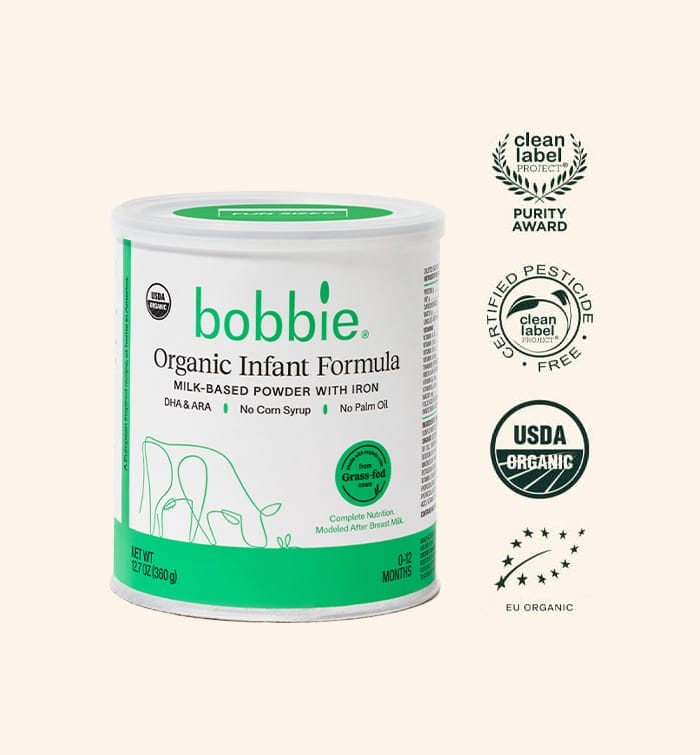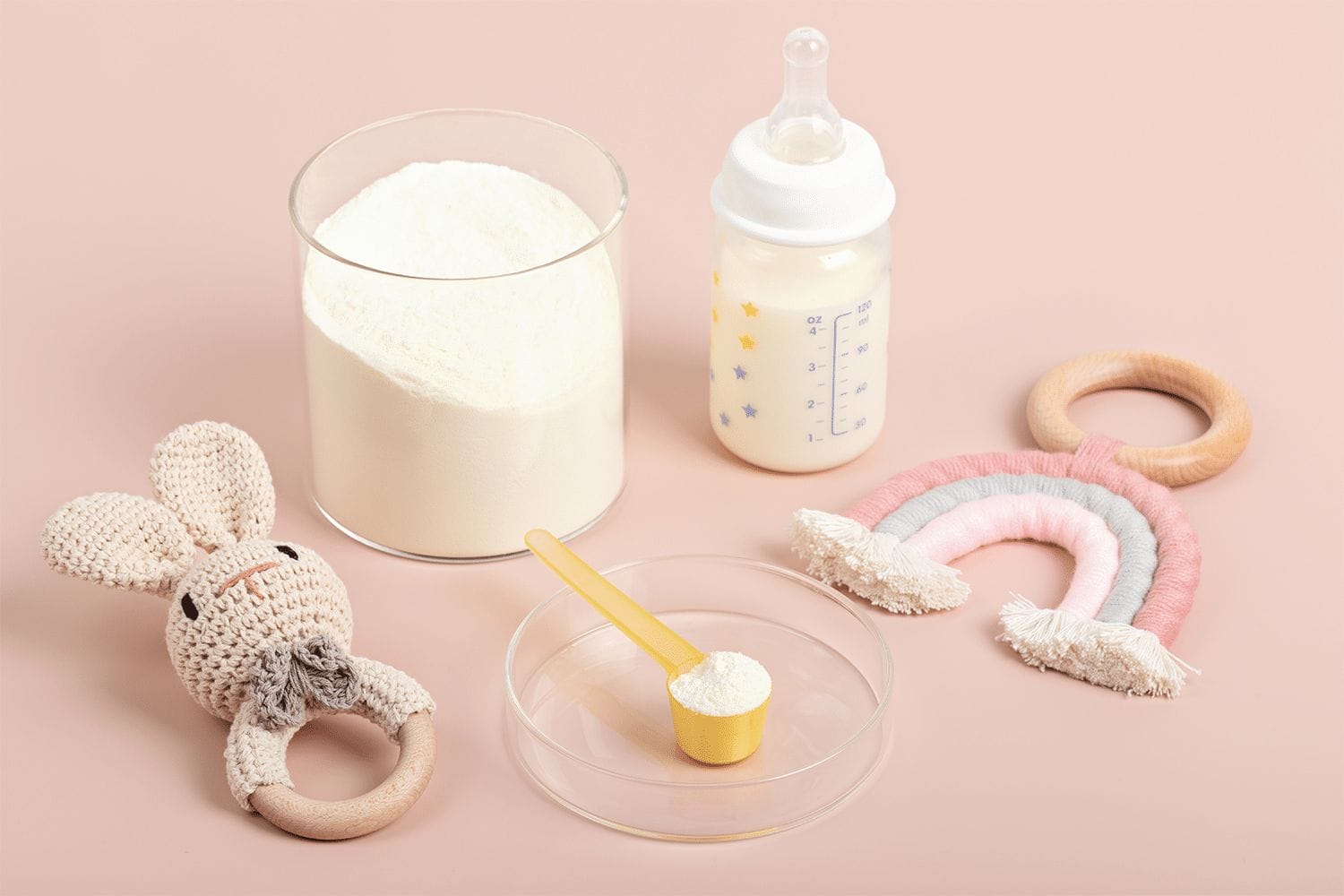We are proud to say that these posts are not sponsored. Our editorial team of Bobbie moms and writers personally select each featured product. If you buy something through our links, we may earn an affiliate commission, at no cost to you.
Parents may decide to switch their baby from breastmilk to infant formula for lots of reasons. Your milk supply may be low, your baby may have an allergy, or you may decide that formula just works better for your family. Whatever the reason, we’ve got all the information you need to make the breast milk to infant formula switch as smooth as possible.
Switching from Breastfeeding to Formula
A large percentage of parents begin the switch from exclusive breastfeeding to formula feeding (either completely or partially) by month 3 or 4. There are many reasons for this switch. Moms often return to work around this time and pumping at work may not be as manageable as many moms had hoped. Some moms simply want more help with feedings from their partner or their child’s care-taker. All of the reasons for switching to infant formula are valid.
Before starting the switch, finding the formula that is best for your baby is the first step.

Shop Bobbie Organic Infant Formula
Bobbie Organic Infant Formula is a USDA Organic, EU-style infant formula that meets all FDA requirements. It is a complete nutrition milk-based powder modeled after breast milk and is easy on tummies. It is non-GMO and doesn't have corn syrup, palm oil, or maltodextrin. Learn more about Bobbie.
What Formula is Best for a Breastfed Baby?
The first step in transitioning your baby from breastmilk to infant formula is to decide which formula to use. It’s important to know that all infant formulas legally sold in the US are regulated by the Food and Drug Administration (FDA) to ensure safety. Be sure to choose one of these options and not a homemade formula or an imported formula that is not regulated by the FDA.
Next, you need to decide between milk-based, soy-based, and hypoallergenic types of formula. If your baby has been breastfeeding well and doesn’t have a milk protein allergy, a milk-based formula is likely to be a good choice. Be sure to talk this decision over with your baby’s healthcare provider, especially if you think your baby may need a special formula.
Finally, you need to decide if you want to use powdered, liquid concentrate, or ready-to-feed infant formula. Powder and liquid concentrate require mixing with water and ready-to-feed doesn’t. Because it’s the most convenient, ready-to-feed is the most expensive while powder is the least expensive.
No matter what formula you choose, be sure to read the formula instructions carefully and follow them exactly when preparing a bottle.
How to Introduce a Bottle to Your Breastfed Baby: 3 Ways to Combination Feed
If you are transitioning to formula and your baby has never taken breastmilk from a bottle before, it will be an important part of the process to introduce the bottle as well as the formula. It may be helpful to take the transition in steps (if you are able) and first introduce the bottle using breast milk before tackling the transition to formula. Check out this list of best bottles for breastfed babies. These can help ease the transition.
If you’re hoping to formula feed while also providing breast milk, know that this can be done. It can happen in whatever increments you would like! Be aware that you’ll likely need to feed or pump 3-4x/day minimum to maintain some measure of breast milk supply. Here are three common ways that parents combination feed (commonly called “combo feeding” or “supplementing”) as they introduce formula.
- Combine bottles – You can add breastmilk to prepared formula in any ratio that you like. Be aware that if you add breastmilk to a bottle with formula that you must follow food safety rules for formula, including tossing the bottle within an hour from the start of the feeding.
- Alternate bottles – In order to conserve breastmilk (which has a longer shelf life), some parents alternate breastmilk bottles with formula bottles. Be aware that some babies may struggle to switch between the two due to the different tastes and textures associated with each.
- Alternate feeding type – Some moms choose to both bottle feed and nurse! For example, some may bottle feed during the day because of daycare and then nurse at home, while others may nurse during the day and bottle feed at night so a partner can help. Whatever works best for your family is totally fine!
7 Tips for Overcoming Bottle Refusal
Despite your best efforts, some babies might have a tougher time with the transition to infant formula or using a baby bottle. The answer isn’t always to try a million different bottles! Try these tricks first and keep practicing.
- Ensure your baby is hungry! Consider pushing feeding time by 5 minutes while you distract. A healthy, term baby will eat if they’re hungry! If they’re not that interested, try again in a bit.
- Mom is out of sight and out of smell distance – but keep something that smells like mom nearby. If someone else is bottle feeding your baby and having trouble, it may help for them to have one of your shirts or another piece of clothing nearby. This way your baby can smell you during the feed, which they may associate with eating.
- Use paced feeding techniques. Feeding the baby while sitting up with the bottle in a horizontal position supports good feeding techniques, even when you’re making a formula switch. Since this is very similar to breastfeeding position, paced bottle feeding is a great way to make this adjustment.
- Try a “dream feed”. Just before you go to bed, after the baby has been asleep for a few hours, try a feeding. Dream feeds usually happen during 10pm and midnight, when you are almost ready to put yourself down for the night. This can encourage longer sleep for the baby (and you!).
- Make the formula a different temperature. It’s safe to feed a baby either cold or warm infant formula, but some babies do have a preference for one or the other. If a certain baby bottle temperature isn’t working well, you can try a different temperature to see if this helps. Just remember, NEVER heat infant formula in a microwave.
- Try bottle feeding skin-to-skin. Since your baby is used to breastfeeding skin to skin, it may feel more natural for them to bottle feed this way. The good news is that this doesn’t have to be mom, this can be your partner or another family member as well.
- Last but not least, try different types of bottles and nipples. Bottles come in a variety of shapes and sizes and nipples come in many forms, including different flow rates. If you experiment with different types of bottles and nipples, you may find that certain ones are a better fit for your baby.
FAQs on Switching from breastmilk to Formula
As answered by Lauren Crosby, MD, FAAP, AAP Spokesperson and Bobbie Medical Advisor.
Can you switch to formula cold turkey?
Dr Crosby: Just like introducing a bottle, it may be best to take some time to transition your baby from breastmilk to formula. Of course, this isn’t always possible, especially if you are making the transition because of a medical issue. Parents may need to pivot to a different formula quickly— and that is perfectly fine to do.
How long does it take a baby to adjust to formula?
Dr Crosby: Sometimes when changing formulas, babies notice a difference in the taste, and this is more common with older babies. Often they get used to a new one quickly, but if they are giving you a hard time you should wait until they are very hungry as then they may be more accepting of a change.
Will switching to formula make a baby fussy?
Dr Crosby: Typically if you’re switching to the same type of formula there shouldn’t be any significant side effects. Some babies are more sensitive to change than others. They might dislike the taste or they might spit up more.
Switching to Formula from Breastmilk
Making the switch from breastmilk to infant formula goes smoothly for some…and not so smoothly for others. If you are able to take it slowly, this may make the process a little easier for you and your baby.
When in doubt, if you’re having any trouble selecting a formula or making the transition, call your baby’s healthcare provider for advice. They are there to help!

Shop Bobbie Organic Infant Formula
Bobbie Organic Infant Formula is a USDA Organic, EU-style infant formula that meets all FDA requirements. It is a complete nutrition milk-based powder modeled after breast milk and is easy on tummies. It is non-GMO and doesn't have corn syrup, palm oil, or maltodextrin. Learn more about Bobbie.

